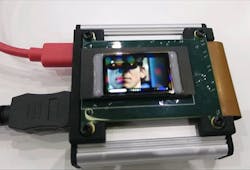Air Force surveys industry for companies to build OLED micro displays for military electronics upgrades
Officials of the Air Force Research Laboratory at Wright-Patterson Air Force Base, Ohio, issued a request for information (FA8650-19-S-5018) on Monday for the Defense Production Act (DPA) Title III Technology Market Research, Organic Light Emitting Diode (OLED) Microdisplay Technology Production Capability project.
OLED is a next-generation display technology that is replacing liquid crystal displays (LCD) in applications like small displays for wearable electronics, mobile micro displays, and small size, weight, and power consumption (SWaP) uses.
OLEDs, which can be about the size of a coin, are made from thin films of organic light emitting materials that emit light when electricity is applied. They have a much simpler structure and have several advantages, compared to LCDs.
Related: Universal Display delivers OLED prototype to U.S. Army
For Air Force purposes, an OLED micro display has a minimum format of 640 by 480 pixels, with and a pixel pitch no larger than 15-microns. Relevant OLEDs must qualify to function in military environments for shock and vibration, and operate in temperatures from -40 to 65 degrees Celsius.
These displays must maintain contrast ratios better than 10,000:1, and a minimum dimming range down to 0.1-foot Lamberts for white. Monochrome brightness must be better than 3,000-foot Lamberts and RGB color OLED better than 50-foot Lamberts, and the displays must be daylight-readable and maintain nighttime performance.
Technology advancements must address achieving a 2,048-by-2,048-pixel color pixel format within a 1.25-inch package that is capable of displaying a minimum of 256 measurably different gray levels.
Air Force researchers also are interested in current and future manufacturing capabilities that will help to create an economically viable military and commercial supplier of military-grade OLED micro-displays.
Related: DARPA eyes flexible displays for the digital battlefield
Companies interested should email their intentions to respond no later than 25 March 2019 to the Air Force's Timothy Kramer at [email protected].
To respond to this request for information email 10-page unclassified white papers to Timothy Kramer at [email protected].
For questions or concerns contact Timothy Kramer by phone at (937-713-9886, or by email at [email protected]. More information is online at https://www.fbo.gov/spg/USAF/AFMC/AFRLWRS/FA8650-19-S-5018/listing.html.
Ready to make a purchase? Search the Military & Aerospace Electronics Buyer's Guide for companies, new products, press releases, and videos

